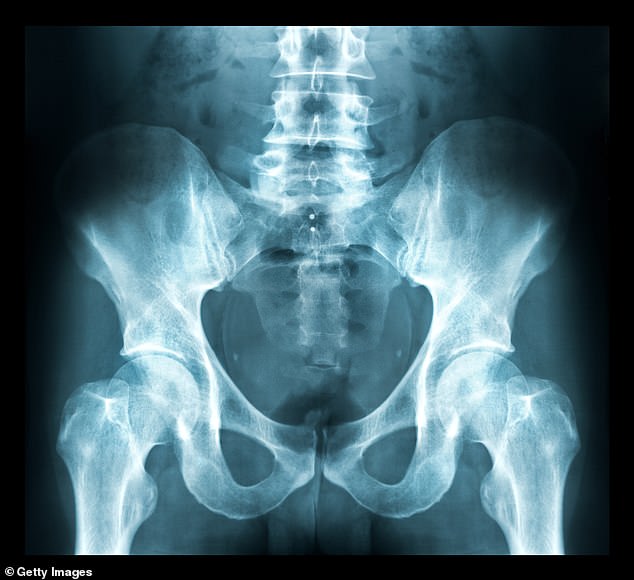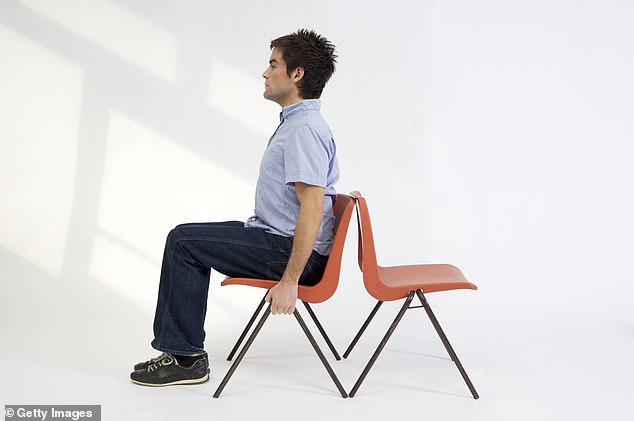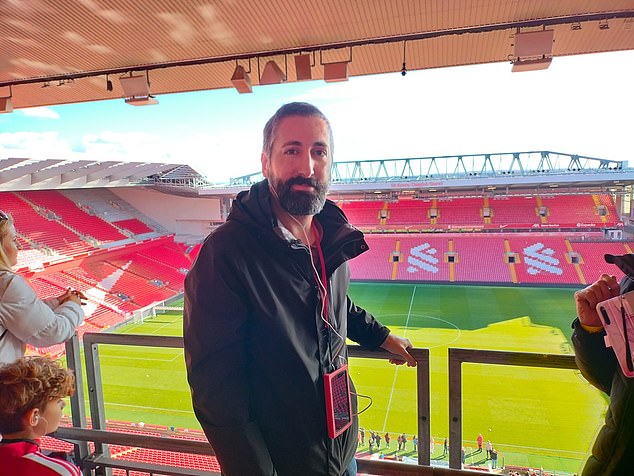Thousands of men suffer from an embarrassing and debilitating condition, although treatment can be as simple as a few minutes of daily exercise. Nearly one in ten men suffer from chronic penile and testicular pain at some point in their lives, which can make dressing uncomfortable and moving around an agony.
Experts say the condition is often mistaken for a sexually transmitted disease or dismissed as a symptom of depression or anxiety.
There is growing research suggesting that these men may be able to effectively heal using a pelvic floor exercise regimen, similar to those recommended for women to combat urinary incontinence after childbirth.
But specialists told The Mail on Sunday the NHS has a “blind spot” in this area of men’s health, meaning the condition, known as chronic pelvic pain syndrome (CPPS), often goes undiagnosed and untreated.
Jose Gonzalez Martinez began experiencing excruciating pain after recovering from a prostate infection. Doctors and scans yielded no clear results until he was referred to Dr Boylan.
Patients are sometimes forced to pay for private treatment because some NHS physiotherapists do not treat men with pelvic floor problems.
Rather, experts say, it is considered a “women’s issue.”
“Thousands of men suffer from these painful spasms in the pelvic area but are repeatedly told there is nothing wrong with them,” says Dr Johnny Boylan, a genitourinary specialist who runs the CPPS clinic at Liverpool University Hospitals NHS Foundation Trust. “Or they are prescribed antibiotics for a possible infection or painkillers.
‘But pain relief won’t solve the problem unless the underlying problem is treated, which we know rarely happens.
“Physiotherapy or simple everyday exercises that they can learn on their own could be life-changing for many of these men, but too often they can’t access them through the NHS. That needs to change.”
It is unclear how many men suffer from CPPS, but research published in the British Medical Journal this year suggested that up to one in 12 men have been affected at some point.
Long-term pain usually occurs in the testicles, perineum (the area between the testicles and the anus), and the tip of the penis.
The sensation is often compared to a burning sensation or electric shocks running through the affected area.
Patients report that the sensation can be so uncomfortable that putting on pants becomes unbearable because the pressure triggers flare-ups.
Pain in the genitals can also be a symptom of serious diseases such as sexually transmitted diseases, kidney stones and even cancer.
This is why experts say it is important for patients experiencing these problems to always visit their primary care physician.
However, many general practitioners are unaware of the symptoms of chronic pain syndrome and are often unable to help affected men.
Studies suggest that in some men, the condition may be caused by an infection.

The pelvic floor is a group of muscles that support the spine, bladder and intestines.
Other patients believe that their chronic pelvic pain syndrome was caused by stress.
Doctors are also often unsure of what causes the condition, or why it affects certain areas of the genitals but not others.
However, experts say it is becoming increasingly clear that chronic pelvic pain syndrome is due to a tightening of the pelvic floor muscles. The pelvic floor, which stretches like a hammock from the pubic bone in front to the tailbone in back, is a group of muscles that support the spine, bladder and bowel.
It also allows us to control urine and bowel movements.
In women, it can weaken after childbirth, causing stress incontinence (urinating or defecating involuntarily when laughing, sneezing, or exercising).
According to the National Health Service, one in three women suffer from urinary incontinence in the first year after having a baby, and many continue to suffer for years. Women are advised to strengthen their pelvic floor by doing Kegel exercises (named after the 20th-century American gynaecologist Dr Arnold Kegel), which involve tensing the pelvic floor muscles for three to five seconds, then relaxing them for three to five seconds and repeating the process.
In June 2021, NHS England announced it was setting up specialist pelvic health clinics, staffed by physiotherapists, to treat tens of thousands of pregnant women and new mums with pelvic floor problems.
Men with chronic pelvic pain syndrome are thought to have the opposite problem to women with stress urinary incontinence. While in women the muscles relax too much, in men the muscles contract and cannot relax.
Over time, this leads to muscle spasms. Experts say that CPPS patients should be offered “reverse Kegel” exercises that relax the muscles (see below for more details).
However, there are no clinics specialising in pelvic health for men. In fact, experts say that many physiotherapists flatly refuse to treat men with pelvic floor problems.
“A large number of men suffer from chronic testicular pain,” says Bill Taylor, a physiotherapist in Edinburgh and member of the Pelvic, Obstetric and Gynaecological Physiotherapy Group, which campaigns to raise awareness of CPPS.
‘It can be incredibly debilitating, it can really affect their lives and even make them feel like life is not worth living.
‘But when you talk to people about men’s pelvic health, they tend to ask, ‘Do men have pelvic floors?’
‘There is an idea that only women have a pelvic floor, and this is even conveyed through GPs and family doctors.
‘Historically, if you worked in pelvic health, you worked in women’s health.
‘Most of the research has focused on women; there hasn’t really been much research done on men.
“We need to educate doctors – GPs, sexual health consultants, urologists, continence specialists – to better understand the problem and know what we, as physiotherapists, can offer, especially to men with chronic testicular pain.”
Dr Johnny Boylan says he has often been unable to find NHS physiotherapists who will accept patients with CPPS.
“I had to give them the names of a private physiotherapist who could help them,” he says.
One man who knows the agony of CPPS – and the frustration of trying to find treatment – is José González Martínez, 37, a hotel worker from Liverpool.
In October 2022, he developed an infection in his prostate, the gland that controls the flow of urine.
Although a two-month course of antibiotics treated the infection, Mr. González Martínez was left with unrelenting pain in his testicles.
He said: “The situation got worse and worse. At first I thought it was a reaction to the infection or the antibiotics.
‘It was there the whole time, although some days it was worse and it got worse if I moved around a lot.
“Sometimes it extended to my groin and belly.”
Assuming the pain was caused by another infection, Mr Gonzalez Martinez’s GP referred him to a sexual health clinic, where he was tested for sexually transmitted diseases including chlamydia, gonorrhea and HIV.
Although he explained that he was happily married and unlikely to have an STD, they repeated the tests a few weeks later.
He said: “I don’t think they believed me, even though all the tests, for both me and my wife, came out fine.”
An ultrasound found no signs of physical damage, so Gonzalez Martinez had to continue fighting.
He said: “No one knew where the pain was coming from. I was still able to work, but it was exhausting and constantly annoying. People told me they could see the pain on my face.”
He was eventually referred to Dr. Boylan.
Realising that the problem was due to his pelvic floor muscles being too tight as a result of the prostate infection, he was prescribed daily exercises to release the tension, as well as nortriptyline, an antidepressant also used for pain relief. He started on 10 mg a day and then increased the dose to 20 mg.
Mr Gonzalez Martinez said: “There was an improvement, quite quickly. I was pain-free for two or three days.
‘For a while, if I moved a lot at work, I sometimes felt pain. But with exercises along with medication, the pain has completely disappeared.
‘The exercises are very easy to do: you just have to tense your pelvic floor and then relax it. I do them for between one and three minutes and I make sure to do them every day.’
Dr Boylan says it is crucial that more funding is allocated to physiotherapists to care for men with CPPS and that GPs and specialists are educated about the symptoms so they can diagnose patients more quickly.
“It’s a shame that it’s so difficult to diagnose and treat such a common disease,” he says.
“We are doing these men a disservice by not providing them with this important part of their treatment.”
Simple seated exercise to help treat genital pain

Relaxing and loosening your pelvic muscles regularly will teach them to move normally again and reduce muscle tension and pain, according to Dr Johnny Boylan, a genitourinary consultant who runs the chronic pelvic pain syndrome clinic at Liverpool University Hospitals NHS Foundation Trust.
A pelvic exercise, known as “down training,” involves sitting in a chair and takes no more than a minute.
It can be done at home, on public transport or at work.
Patients are asked to uncross their knees and place their feet apart on the floor.
Then let your jaw go loose and your teeth separate.
The belly is supposed to relax and the buttocks are supposed to loosen.
Next, patients should take a deep breath, gently expanding the stomach. This should be repeated five times in one session. Another option is to stand in front of a mirror without underwear and lift the testicles towards the body by tightening the pelvic muscles. These are the muscles that are tightened or loosened to go to the bathroom. When the pelvic floor is tight, the anus should feel tight.
Patients are then asked to relax again and let the testicles hang freely. Letting the abdomen hang freely will also help the pelvic floor muscles relax.
The important thing about this exercise is relaxation. Regular practice makes it easier. That is why it is important for patients to perform these exercises for several minutes every day. However, it is essential not to force yourself while tensing the pelvic muscles, as this can exacerbate the pain.

